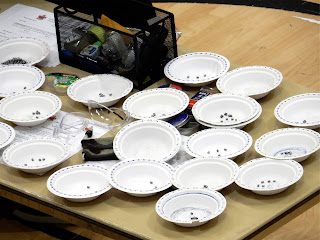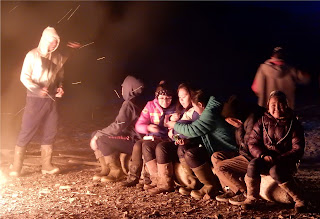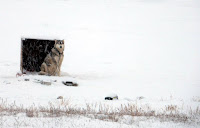A
really big announcement was made two & a half weeks ago and I would like to
address it here. You most likely already
know about it and I’m aware I could have mentioned it in my last post, but it
would have felt tacked on at the end. I
also thought about writing a separate post, but it would have been a very short
one. And we all know how much I prefer
to write large posts.
First,
a quick backstory. Becky Han, an Inuk
singer, song-writer, and activist, posted a tweet on her Twitter account in
late September, asking for clothing donations so she could send them to Inuujaq
School in Arctic Bay. Originally, school
administration had asked for snow pants because winter was fast approaching and
there are many children who need them.
Her calls on Twitter were widely shared and were noticed by Canadian
actor & film producer Ryan Reynolds.
He’s quite famous in Canada & the USA. Most people up here know him from the Deadpool
film series.
Mr.
Reynolds contacted Becky & later the school to inform them that he wanted
to help. He got in touch with the
clothing company Canada Goose and made a deal with them to provide 300 jackets,
Baffin Boots, and other winter gear to the students. The actor was quoted saying that Canada Goose
“went so far and beyond matching me.” I
can assume he and the company split the clothing & shipping costs
somehow. Of course, such information
will most likely stay secret for a very long time.
You
can read more about the announcement from the following news sites:
APTN
– A Tweet, A Parka Company, And A Response From Ryan Reynolds
Nunatsiaq
News – Warm Winter Clothes Head To Nunavut . . .
Nunavut
News – Ryan Reynolds And Canada Goose Donate 300 Parkas To Arctic Bay
The
excitement here has been nonstop for the last two weeks. Everyone in town has been talking about
it. Some clothing donations have already
been received – thank you! – but they’re not from Ryan Reynolds & Canada Goose. The school is anxiously waiting for
the big order to arrive. We’ve all been
asking ourselves if everything will be delivered at once or in small
batches. Shipping that many clothes
require a lot of space. I wonder if a
charter plane will be hired to fly everything in. Either way, if you’re reading this Mr.
Reynolds, the students & people of Arctic Bay thank you immensely for your
generosity. When the COVID-19 pandemic
ends and the travel restrictions are lifted, please come visit the community
& Inuujaq School.
One of my coworkers hosted a Thanksgiving Dinner at her place on October 10. I was unable to attend because I was supervising cadets burning wood behind the airport. She prepared a take home meal for me in a large aluminum pan. Thank you! I didn’t have to worry about dinner for two nights after the long weekend. She also added that she & her guests could see the bonfire from her house.
Fast forward to Saturday, October 24. The next big event for the cadets of 3045 was the annual Fall Biathlon competition. The corps takes over the school’s gym for the morning & afternoon, and converts it into an air rifle range. The competition is a timed relay race where participants shoot .177 lead pellets at metal plinker targets and run outside for a kilometre. All participants shoot & run three times except for the 1st year cadets. They only run twice. The running is supposed to simulate cross country skiing. Unfortunately, there isn’t enough snow on the ground for the real thing. The goal is to complete your relay in the least amount of time.
The cadets arrived at 9:30am for setup. There was a lot of equipment to bring out. Plinker targets, backboards, sandbags, tables, chairs, flags, air rifles, mats, pellets, clipboards, stop watches, pens, Meals-Ready-to-Eat (MREs), coffee machine, hot water urn, cups, & Coleman stoves, just to name a few. Even though lunch was two hours away, it was better to have everything out and ready to go. That and we needed to have boiling water ready for the MRE pouches. You don’t want to keep hungry cadets waiting.
 |
| Start Line. |
When the air rifle range was ready to go, the cadets were formed up for a general briefing. I welcomed them and explained how the day was to proceed. The corps only has three plinker targets so only three cadets would go at a time. Yes, technically we could have more go, but that would require “stopping & starting the clock” on paper a lot to calculate the correct times. I decided to make it easier for the time keepers by having a dedicated stop watch & shooting lane for each competitor. Participants would complete their relays in any given order. I put my trust in the cadets to volunteer when they were ready. Lastly, the cadets were divided into three groups: 1st year cadets; 2nd year cadets; seniors.
The
competition began at 10:30am.
A routine quickly established itself when the first three competitors began. The cadets would start running, leave for some time, return, shoot in the prone position, and then leave. Cadets who were waiting were put to work refilling the pellet bowls and noting the targets the competitors did not hit. Frank kept some of the cadets busy upstairs by having them identify the provincial & territorial flags. Pretty soon it was 11:30am. The senior cadets fired up the Coleman stoves and started bowling water. The competition was stopped at 12pm for lunch.
The cadets labelled their main meal pouches and placed them in the pots of boiling water. The meals were ready to eat after 15 minutes. I prepared mine last because officers east last. The cadets brought out extra tables & chairs so they could eat in the gym. Lunch lasted for an hour and the cadets cleaned up the eating area.
The competition continued in the afternoon. The remaining participants volunteered when they were ready to start their relays. I continued to monitor the stop watches and scoresheets. A few cadets continued making sure the pellet bowls contained five pellets. The competition was done by 2:45pm. Everyone spent the next 20 minutes cleaning the gym & putting everything away. The scorecards were placed in a sealed envelope and placed in the cadet office. I told the cadets I would review them at a later date. The winners of each categories would be announced in the near future.
There were a lot of boats swarming around the bay while I was walking home after the competition. I was surprised to see boats in late October because the bay usually freezes by this time. The boaters were hunting narwhals. There must have been narwhals swimming near the shoreline because quite a few boats found themselves floating close to land. Being so close to the community prevented the hunters from using guns. They could only use harpoons.
I stopped and watched them for a few minutes and then continued walking home. I had to school work to prepare. I assumed a few narwhals would be caught.










































